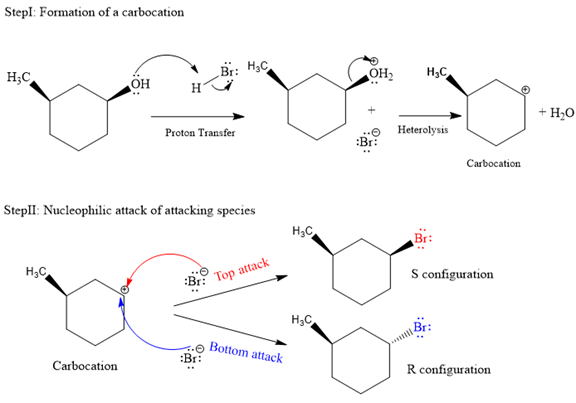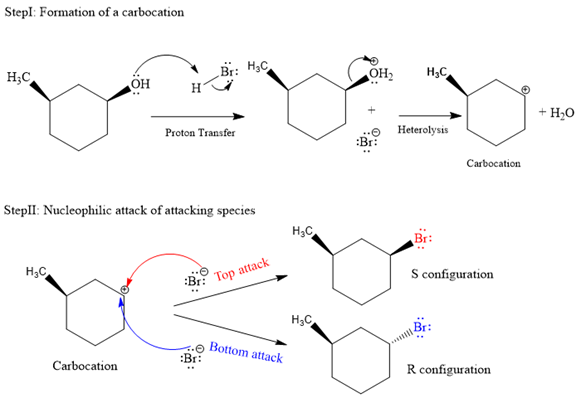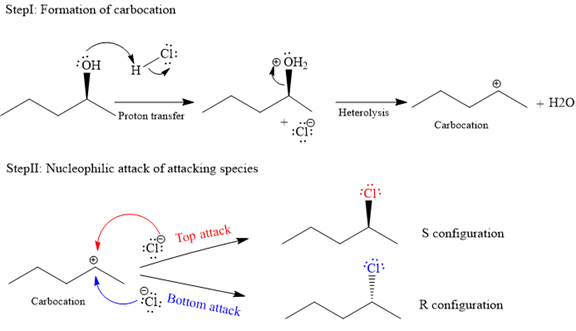
Concept explainers
(a)
Interpretation:
The complete and detailed mechanism is to be drawn for the given reaction.
Concept introduction:
The SN1 is an abbreviation for unimolecular nucleophilic substitution reaction. These reactions are two-step reactions. The first step is the formation of carbocation intermediate, followed by the nucleophilic attack, which is a second step. Due to the formation of a planar carbocation, the incoming nucleophile can attack the carbocation from two sides, either from the front of the plane or from the back side of the plane.
This leads to give the mixture of stereoisomers. When secondary and tertiary alcohols are treated with strong concentrated acids, it follows SN1 and E1 mechanism.
Answer to Problem 10.1P
The complete and detailed mechanism for given reaction is as follows:

Explanation of Solution
The given reaction is as follows:

The hydroxyl (
The departure of water is a slow step that leads to formation of carbocation, and thus it is the rate-determining step. Due to the formation of planar carbocation intermediate, the incoming nucleophile can attack from either sides, either the top (from above the plane) or bottom (from below of plane). The bromide ion formed in the proton transfer step is the attacking species in the second step of the mechanism. In the second step, the bromide ion (
Both top and bottom attack of nucleophile are possible leads to formation of the mixture of isomers, as shown below:

Due to the formation of carbocation intermediate in SN1 reaction, a mixture of stereoisomer is produced.
(b)
Interpretation:
The complete and detailed mechanism is to be drawn for the given reaction.
Concept introduction:
The SN1 is an abbreviation for unimolecular nucleophilic substitution reaction. These reactions are two-step reactions. The first step is the formation of carbocation intermediate, followed by the nucleophilic attack of attacking species, which is a second step. Due to the formation of a planar carbocation, the incoming nucleophile can attack the carbocation from two sides, either from the front of the plane or from the back side of the plane.
This leads to give the mixture of stereoisomers. When secondary and tertiary alcohols are treated with strong concentrated acids, it follows SN1 and E1 mechanism.
Answer to Problem 10.1P
The complete and detailed mechanism for given reaction is as follows:

Explanation of Solution
The given reaction is as follows:

The hydroxyl (
Both top and bottom attack of nucleophile are possible leads to formation of the mixture of isomers, as shown below:

Due to the formation of carbocation intermediate in SN1 reaction, a mixture of stereoisomer is produced.
Want to see more full solutions like this?
Chapter 10 Solutions
EBK ORGANIC CHEMISTRY: PRINCIPLES AND M
- In a benzene derivative that has -CH2CH3, indicate how it can be substituted by -COOH.arrow_forwardIn a sulfonated derivative of benzene, indicate how -SO3H can be eliminated.arrow_forwardWhat is the equilibrium expression (law of mass action) for the following reaction:CO2 (g) + H2O (l) ⇋ H+ (aq) + HCO3- (aq)arrow_forward
- Indicate the compound resulting from adding NaOH cyclopentane-CH2-CHO.arrow_forwardUse the provided information to calculate Kc for the following reaction at 550 °C: H2(g) + CO2(g) ⇌ CO(g) + H2O(g) Kc = ?CoO(s) + CO(g) ⇌ Co(s) + CO2(g) Kc1 = 490CoO(s) + H2(g) ⇌ Co(s) + H2O(g) Kc2 = 67arrow_forwardCalculate Kc for the reaction: I2 (g) ⇋ 2 I (g) Kp = 6.26 x 10-22 at 298Karrow_forward
- For each scenario below, select the color of the solution using the indicator thymol blue during the titration. When you first add indicator to your Na2CO3solution, the solution is basic (pH ~10), and the color is ["", "", "", "", ""] . At the equivalence point for the titration, the moles of added HCl are equal to the moles of Na2CO3. One drop (or less!) past this is called the endpoint. The added HCl begins to titrate the thymol blue indicator itself. At the endpoint, the indicator color is ["", "", "", "", ""] . When you weren't paying attention and added too much HCl (~12 mL extra), the color is ["", "", "", "", ""] . When you really weren't paying attention and reached the second equivalence point of Na2CO3, the color isarrow_forwardTo convert cyclopentane-CH2-CHO to cyclopentane-CH2-CH3, compound A is added, followed by (CH3)3CO-K+, DMS at 100oC. Indicate which compound A is.arrow_forwardIndicate how to obtain the compound 2-Hydroxy-2-phenylacetonitrile from phenylmethanol.arrow_forward
- Indicate the reagent needed to go from cyclopentane-CH2-CHO to cyclopentane-CH2-CH=CH-C6H5.arrow_forwardesc Write the systematic name of each organic molecule: structure CH3 CH3-C=CH2 CH3-CH2-C-CH2-CH3 CH-CH3 CH3 ☐ ☐ ☐ CI-CH-CH=CH2 Explanation Check F1 F2 name 80 F3 F4 F5 F6 A 7 ! 2 # 3 4 % 5 6 & 7 Q W E R Y FT 2025 Mcarrow_forwardTwo reactants X and Z are required to convert the compound CH3-CH2-CH2Br to the compound CH3-CH2-CH=P(C6H5)3. State reactants X and Z.arrow_forward
 Organic Chemistry: A Guided InquiryChemistryISBN:9780618974122Author:Andrei StraumanisPublisher:Cengage Learning
Organic Chemistry: A Guided InquiryChemistryISBN:9780618974122Author:Andrei StraumanisPublisher:Cengage Learning
